Centauri Dreams
Imagining and Planning Interstellar Exploration
Fine-Tuning New Horizons’ Trajectory
I love the timing of New Horizons’ next encounter, just as we begin a new year in 2019. On the one hand, we’ll be able to look back to a mission that has proven successful in some ways beyond the dreams of its creators. On the other hand, we’ll have the first close-up brush past a Kuiper Belt Object, 2014 MU69 or, as it’s now nicknamed, Ultima Thule. This farthest Solar System object ever visited by a spacecraft may, in turn, be followed by yet another still farther, if all goes well and the mission is extended. This assumes, of course, another target in range.
We can’t rule out a healthy future for this spacecraft after Ultima Thule. Bear in mind that New Horizons seems to be approaching its current target along its rotational axis. That could reduce the need for additional maneuvers to improve visibility for the New Horizons cameras, saving fuel for later trajectory changes if indeed another target can be found. The current mission extension ends in 2021, but another extension would get a powerful boost if new facilities like the Large Synoptic Survey Telescope become available, offering more capability at tracking down an appropriate KBO. Hubble and New Horizons itself will also keep looking.
But even lacking such a secondary target, an operational New Horizons could return useful data about conditions in the outer Solar System and the heliosphere, with the spacecraft’s radioisotope thermoelectric generator still producing sufficient power for some years. I’ve seen a worst-case 2026 as the cutoff point, but Alan Stern is on record as saying that the craft has enough hydrazine fuel and power from its plutonium generator to stay functional until 2035.
By way of comparison with Voyager, which we need to revisit tomorrow, New Horizons won’t reach 100 AU until 2038, nicely placed to explore the heliosphere if still operational.
But back to Ultima Thule, a destination now within 112 million kilometers of the spacecraft. New Horizons is closing at a rate of 14.4 kilometers per second, enroute to what the New Horizons team says will need to be a 120 by 320 kilometer ‘box’ in a flyby that needs to be predicted within 140 seconds. Based on what we saw at Pluto/Charon, these demands can be met.

Image: At left, a composite optical navigation image, produced by combining 20 images from the New Horizons Long Range Reconnaissance Imager (LORRI) acquired on Sept. 24. The center photo is a composite optical navigation image of Ultima Thule after subtracting the background star field; star field subtraction is an important component of optical navigation image processing since it isolates Ultima from nearby stars. At right is a magnified view of the star-subtracted image, showing the close proximity and relative agreement between the observed and predicted locations of Ultima. Credit: NASA/JHUAPL/SwRI/KinetX.
Above are the latest navigation images from New Horizons’ Long Range Reconnaissance Imager (LORRI). An engine burn on October 3 further tightened location and timing information for the New Year’s flyby, a 3 ½ minute maneuver that adjusted the spacecraft’s trajectory and increased its speed by 2.1 meters per second. Records fall every time New Horizons does this, with the October 3 correction marking the farthest course correction ever performed.
It’s interesting to learn, too, that this is the first time New Horizons has made a targeting maneuver for the Ultima Thule flyby that used pictures taken by New Horizons itself. The ‘aim point’ is 3,500 kilometers from Ultima at closest approach, and we’ve just learned that these navigation images confirm that Ultima is within 500 kilometers of its expected position.
“Since we are flying very fast and close to the surface of Ultima, approximately four times closer than the Pluto flyby in July 2015, the timing of the flyby must be very accurate,” said Derek Nelson, of KinetX Aerospace, Inc., New Horizons optical navigation lead. “The images help to determine the position and timing of the flyby, but we must also trust the prior estimate of Ultima’s position and velocity to ensure a successful flyby. These first images give us confidence that Ultima is where we expected it to be, and the timing of the flyby will be accurate.”
I’m already imagining New Year’s eve with Ultima Thule to look forward to. You can adjust your own plans depending on your time zone, but the projected flyby time is 0533 UTC on the 1st. As with Pluto/Charon, the excitement of the encounter continues to build. In the broader picture, the more good science we do in space, the more drama we produce as we open up new terrain. This week alone, we need to look at the Hayabusa2 operations at Ryugu, the upcoming OSIRIS-REx exploration of asteroid Bennu, and the continuing saga of Voyager 2.
But New Horizons also reminds us of an uncomfortable fact. When it comes to the outer system, this is the only spacecraft making studies of the Kuiper Belt from within it, and there is no other currently planned. Data from this mission will need to carry us for quite some time.
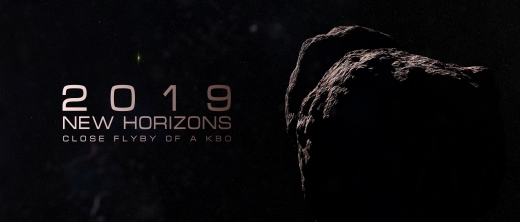
DE-STAR and Breakthrough Starshot: A Short History
Last Monday’s article on the Trillion Planet Survey led to an email conversation with Phil Lubin, its founder, in which the topic of Breakthrough Starshot invariably came up. When I’ve spoken to Dr. Lubin before, it’s been at meetings related to Starshot or presentations on his DE-STAR concept. Standing for Directed Energy System for Targeting of Asteroids and exploRation, DE-STAR is a phased laser array that could drive a small payload to high velocities. We’ve often looked in these pages at the rich history of beamed propulsion, but how did the DE-STAR concept evolve in Lubin’s work for NASA’s Innovative Advanced Concepts office, and what was the path that led it to the Breakthrough Starshot team?
The timeline below gives the answer, and it’s timely because a number of readers have asked me about this connection. Dr. Lubin is a professor of physics at UC-Santa Barbara whose primary research beyond DE-STAR has involved the early universe in millimeter wavelength bands, and a co-investigator on the Planck mission with more than 400 papers to his credit. He is co-recipient of the 2006 Gruber Prize in Cosmology along with the COBE science team for their groundbreaking work in cosmology. Below, he tells us how DE-STAR emerged.
By Philip Lubin

June 2009: Philip Lubin begins work on large scale directed energy systems at UC Santa Barbara. Baseline developed is laser phased array using MOPA [master oscillator power amplifier, a configuration consisting of a master laser (or seed laser) and an optical amplifier to boost the output power] topology. The DE system using this topology is named DE-STAR (Directed Energy System for Targeting Asteroids and exploRation). Initial focus is on planetary defense and relativistic propulsion. Development program begins. More than 250 students involved in DE R&D at UCSB since.
February 14, 2013: UCSB group has press release about DE-STAR program to generate public discussion about applications of DE to planetary defense in anticipation of February 15 asteroid 2012 DA14, which was to come within geosync orbit. On February 15 Chelyabinsk meteor/asteroid hit. This singular coincidence of press release and hit the next day generated a significant change in interest in possible use of large scale DE for space applications. This “pushed the DE ball over the hill”.
August 2013: Philip Lubin and group begin publication of detailed technical papers in multiple journals. DE-STAR program is introduced at invited SPIE [Society of Photo-optical Instrumentation Engineers] plenary talk in San Diego at Annual Photonics meeting. More than 50 technical papers and nearly 100 colloquia from his group have emerged since then. List of DE-STAR papers can be found here.
August 2013: 1st Interstellar Congress held in Dallas, Texas by Icarus Interstellar. Eric Malroy introduces concepts for the use of nanomaterials in sails.
August 2013: First proposal submitted to NASA for DE-STAR system from UC Santa Barbara.
January 2014: Work begins on extending previous UCSB paper to much longer “roadmap” paper which becomes “A Roadmap to Interstellar Flight” (see below).
February 11, 2014 – Lubin gives colloquium on DE-STAR at the SETI Institute in Mountain View, CA. Summarizes UCSB DE program for planetary defense, relativistic propulsion and implications for SETI. SETI Institute researchers suggest Lubin speak with NASA Ames director Pete Worden as he was not at the talk. Worden eventually leaves Ames a year later on March 31, 2015 to go to the Breakthrough Foundation. Lubin and Worden do not meet until 18 months later at the Santa Clara 100YSS meeting (see below).
August 2014: Second proposal submitted to NASA for DE-STAR driven relativistic spacecraft. Known as DEEP-IN (Directed Energy Propulsion for Interstellar Exploration). Accepted and funded by NASA NIAC program as Phase I program. Program includes directed energy phased array driving wafer scale spacecraft as one option [Phase 1 report “A Roadmap to Interstellar Flight” available here].
April 2015: Lubin submits the “roadmap” paper to the Journal of the British Interplanetary Society.
June 2015: Lubin presents DE driven relativistic flight at Caltech Keck Institute meeting. Meets with Emmett and Glady W Technology Fund.
August 31, 2015: August 31, 2015: Lubin and Pete Worden attend 100YSS (100 Year Star Ship) conference in Santa Clara, CA [Worden is now executive director, Breakthrough Starshot, and former director of NASA Ames Research Center]. Lubin is invited by Mae Jemison (director of 100YSS) to give a talk about the UCSB NASA DE program as a viable path to interstellar flight. Worden has to leave before Lubin’s talk, but in a hallway meeting Lubin informs Worden of the UCSB NASA Phase I NASA program for DE driven relativistic flight. This meeting takes places as Lubin recalls Feb 2014 SETI meeting where a discussion with Worden is suggested. Worden asks for further information about the NASA program and Lubin sends Worden the paper “A Roadmap to Interstellar Flight” summarizing the NASA DEEP-IN program. Worden subsequently forwards paper to Yuri Milner.
December 16, 2015: Lubin, Worden and Pete Klupar [chief engineer at Breakthrough Prize Foundation] meet at NASA Ames to discuss DEEP-IN program and “roadmap” paper.
December 2015: Milner calls for meeting with Lubin to discuss DEEP-IN program, “roadmap” paper and the prospects for relativistic flight.
January 2016: Private sector funding of UCSB DE for relativistic flight effort by Emmett and Glady W Technology Fund begins. Unknown to public – anonymous investor greatly enhances UCSB DE effort.
January 2016: First meeting with Milner in Palo Alto. Present are Lubin, Milner, Avi Loeb (Harvard University), Worden and Klupar. Milner sends “roadmap” paper to be reviewed by other physicists. A long series of calls and meetings ensue. This begins the birth of Breakthrough Starshot program.
March 2016 – NASA Phase II proposal for DEEP-IN submitted. Renamed Starlight subsequently. Accepted and funded by NASA.
March 2016: After multiple reviews of Lubin “roadmap” paper by independent scientists, Breakthrough Initiatives endorses idea of DE driven relativistic flight.
April 12, 2016: Public release of Breakthrough Starshot. Hawking endorses idea at NY public announcement.
To keep up with developments, the following websites are useful:
NASA Starlight (DE-STAR for interstellar relativistic flight):
http://www.deepspace.ucsb.edu/projects/starlight
Planetary Defense Application of DE-STAR:
http://www.deepspace.ucsb.edu/projects/directed-energy-planetary-defense
Implications for SETI:
http://www.deepspace.ucsb.edu/projects/implications-of-directed-energy-for-seti

2015 TG387: A New Inner Oort Object & Its Implications
Whether or not there is an undiscovered planet lurking in the farthest reaches of the Solar System, the search for unknown dwarf planets and other objects continues. Extreme Trans-Neptunian objects (ETNOs) are of particular interest. The closest they come to the Sun is well beyond the orbit of Neptune, with the result that they have little gravitational interaction with the giant planets. Consider them as gravitational probes of what lies beyond the Kuiper Belt.
Among the population of ETNOs are the most distant subclass, known as Inner Oort Cloud objects (IOCs), of which we now have three. Added to Sedna and 2012 VP113 comes 2015 TG387, discovered by Scott Sheppard (Carnegie Institution for Science), Chad Trujillo (Northern Arizona University) and David Tholen (University of Hawai?i). The object was first observed in 2015, leading to several years of follow-up observations necessary to obtain a good orbital fit.
For 2015 TG387 is a challenging catch, discovered at about 80 AU from the Sun but normally at far greater distance:
“We think there could be thousands of small bodies like 2015 TG387 out on the Solar System’s fringes, but their distance makes finding them very difficult,” Tholen said. “Currently we would only detect 2015 TG387 when it is near its closest approach to the sun. For some 99 percent of its 40,000-year orbit, it would be too faint to see, even with today’s largest telescopes.”

Image: The orbits of the new extreme dwarf planet 2015 TG387 and its fellow Inner Oort Cloud objects 2012 VP113 and Sedna, as compared with the rest of the Solar System. 2015 TG387 was nicknamed “The Goblin” by its discoverers, since its provisional designation contains “TG”, and the object was first seen around Halloween. Its orbit has a larger semi-major axis than both 2012 VP11 and Sedna, so it travels much farther from the Sun, out to 2300 AU. Credit: Roberto Molar Candanosa and Scott Sheppard / Carnegie Institution for Science.
Perihelion, the closest distance this object gets to the Sun, is now calculated at roughly 65 AU, so we are dealing with an extremely elongated orbit. 2015 TG387 has, after VP113 and Sedna (80 and 76 AU respectively), the third most distant perihelion known, but it has a larger orbital semi-major axis, so its orbit carries it much further from the Sun than either, out to about 2,300 AU. At these distances, Inner Oort Cloud objects are all but isolated from the bulk of the Solar System’s mass.
You may recall that it was Sheppard and Trujillo who discovered 2012 VP113 as well, triggering a flurry of investigation into the orbits of such worlds. The gravitational story is made clear by the fact that Sedna, 2012 VP113 and 2015 TG387 all approach perihelion in the same part of the sky, as do most known Extreme Trans-Neptunian objects, an indication that their orbits are being shaped by something in the outer system. Thus the continuing interest in so-called Planet X, a hypothetical world whose possible orbits were recently modeled by Trujillo and Nathan Kaib (University of Oklahoma).
The simulations show the effect of different Planet X orbits on Extreme Trans-Neptunian objects. In 2016, drawing on previous work from Sheppard and Trujillo, Konstantin Batygin and Michael Brown examined the orbital constraints for a super-Earth at several hundred AU from the Sun in an elliptical orbit. Including such a world in their simulations, the latter duo were able to show that several presumed planetary orbits could result in stable orbits for other Extreme Trans-Neptunian objects. Let’s go to the paper to see how 2015 TG387 fits into the picture:
…Trujillo (2018) ran thousands of simulations of a possible distant planet using the orbital constraints put on this planet by Batygin and Brown (2016a). The simulations varied the orbital parameters of the planet to identify orbits where known ETNOs were most stable. Trujillo (2018) found several planet orbits that would keep most of the ETNOs stable for the age of the solar system.
So we’ve fit the simulated orbit with Sedna, 2012 VP113 and other ETNOs. The next step was obvious:
To see if 2015 TG387 would also be stable to a distant planet when the other ETNOs are stable, we used several of the best planet parameters found by Trujillo (2018). In most simulations involving a distant planet, we found 2015 TG387 is stable for the age of the solar system when the other ETNOs are stable. This is further evidence the planet exists, as 2015 TG387 was not used in the original Trujillo (2018) analysis, but appears to behave similarly as the other ETNOs to a possible very distant massive planet on an eccentric orbit.

Image: Movie of the discovery images of 2015 TG387. Two images were taken about 3 hours apart on October 13, 2015 at the Subaru Telescope on Maunakea, Hawai?i. 2015 TG387 can be seen moving between the images near the center, while the more distant background stars and galaxies remain stationary. Credits: Dave Tholen, Chad Trujillo, Scott Sheppard.
We know very little about 2015 TG387 itself, though the paper, assuming a moderate albedo, finds a likely diameter in the range of 300 kilometers. The stability of this small object’s orbit, keeping it aligned and stable in relation to the eccentric orbit of the hypothesized Planet X, supports the existence of the planet, especially since the derived orbit of 2015 TG387 was determined after the Planet X orbital simulations. Despite this, notes the paper in conclusion, “…2015 TG387 reacts with the planet very similarly to the other known IOCs and ETNOs.”
Another interesting bit: There is a suggestion that ETNOs in retrograde orbit are stable. Given this, the authors do not rule out the idea that the planet itself might be on a retrograde orbit.
The paper is Sheppard et al., “A New High Perihelion Inner Oort Cloud Object,” submitted to The Astronomical Journal (preprint).

Kepler 1625b: Orbited by an Exomoon?
8,000 light years from Earth in the constellation Cygnus, the star designated Kepler 1625 may be harboring a planet with a moon. The planet, Kepler 1625b, is a gas giant several times the mass of Jupiter. What David Kipping (Columbia University) and graduate student Alex Teachey have found is compelling though not definitive evidence of a moon orbiting the confirmed planet.
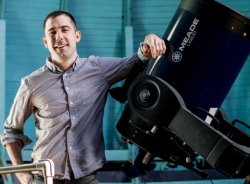
If we do indeed have a moon here, and upcoming work should be able to resolve the question, we are dealing, at least in part, with the intriguing scenario many scientists (and science fiction writers) have speculated about. Although a gas giant, Kepler 1625b orbits close to or within the habitable zone of its star. A large, rocky moon around it could be a venue for life, but the moon posited for this planet doesn’t qualify. It’s quite large — roughly the size of Neptune — and like its putative parent, a gaseous body. If we can confirm the first exomoon, we’ll have made a major advance, but the quest for habitable exomoons does not begin around Kepler 1625b.
Image: Columbia’s Alex Teachey, lead author of the paper on the detection of a potential exomoon. Credit: Columbia University.
None of this should take away from the importance of the detection, for exploring moons around exoplanets will doubtless teach us a great deal about how such moons form. Unlike the Earth-Moon system, or the Pluto/Charon binary in our own Solar System, Kepler-1625b’s candidate moon would not have formed through a collision between two rocky bodies early in the history of planetary development. We’d like to learn how it got there, if indeed it is there. Far larger than any Solar System moon, it is estimated to be but 1.5% of its companion’s mass.

The methods David Kipping has long espoused through the Hunt for Exomoons with Kepler (HEK) project have come to fruition here. Working with data on 284 planets identified through the Kepler mission, each of them with orbital periods greater than 30 days, Kipping and Teachey found interesting anomalies at Kepler-1625b, where Kepler had recorded three transits. The lightcurves produced by these transits across the face of the star as seen from the spacecraft showed deviations that demanded explanation.
Image: Exomoon hunter David Kipping. Credit: Columbia University.
Their interest heightened, the researchers requested and were awarded 40 hours of time on the Hubble Space Telescope, whose larger aperture could produce data four times more precise than that available from Kepler. On October 28 and 29 of 2017, the scientists took data through 26 Hubble orbits. Examining the lightcurve of a 19-hour long transit of Kepler-1625b, they noted a second, much smaller decrease in the star’s light some 3.5 hours later.
Kipping refers to it as being consistent with “…a moon trailing the planet like a dog following its owner on a leash,” but adds that the Hubble observation window closed before the complete transit of the candidate moon could be measured. The paper addresses this second dip:
The most compelling piece of evidence for an exomoon would be an exomoon transit, in addition to the observed TTV [transit timing variation]. If Kepler-1625b’s early transit were indeed due to an exomoon, then we should expect the moon to transit late on the opposite side of the barycenter. The previously mentioned existence of an apparent flux decrease toward the end of our observations is therefore where we would expect it to be under this hypothesis. Although we have established that this dip is most likely astrophysical, we have yet to discuss its significance or its compatibility with a self-consistent moon model.
In and of itself, this is exciting information, but as noted above, we also learn in this morning’s paper in Science Advances that transit timing variations are apparent here. The planet itself began its transit 77.8 minutes earlier than predicted. One way to account for this is by the pull of a moon on the planet, resulting in their both orbiting a common center of gravity and thus throwing the transit calculation (based on an unaccompanied planet) off. What Kipping and Teachey will need to eliminate is the possibility that a second planet, yet undetected, could have caused the timing variation. There is thus far no evidence from Kepler of such a planet.
“A companion moon is the simplest and most natural explanation for the second dip in the light curve and the orbit-timing deviation,” said lead author Teachey. “It was a shocking moment to see that light curve, my heart started beating a little faster and I just kept looking at that signature. But we knew our job was to keep a level head testing every conceivable way in which the data could be tricking us until we were left with no other explanation.”
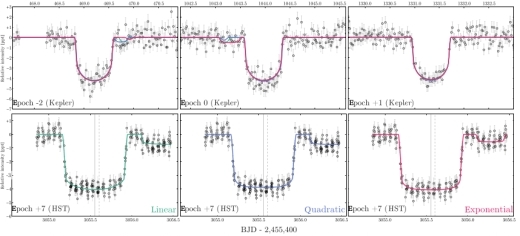
Image: This is Figure 4 from the paper. Caption: Moon solutions. The three transits in Kepler (top) and the October 2017 transit observed with HST (bottom) for the three trend model solutions. The three colored lines show the corresponding trend model solutions for model M, our favored transit model. The shape of the HST transit differs from that of the Kepler transits owing to limb darkening differences between the bandpasses. Credit: David Kipping, Alex Teachey.
One problem with exomoon hunting is that the ideal candidate planets are those in wide orbits, but this makes for long periods between transits. Even so, the number of large planets in orbits farther from their star than 1 AU is growing, and such worlds should be useful targets for the upcoming James Webb Space Telescope. Although we still have to confirm Kepler-1625b’s moon, such a confirmation could prove only the beginning of a growing exomoon census.
We’ll know more as we make more detections, but for now, I think Kipping and Teachey’s caution is commendable. Noting that confirmation will involve long scrutiny, observations and skepticism from within the community, they point out:
…it is difficult to assign a precise probability to the reality of Kepler-1625b-i. Formally, the preference for the moon model over the planet-only model is very high, with a Bayes factor exceeding 400,000. On the other hand, this is a complicated and involved analysis where a minor effect unaccounted for, or an anomalous artifact, could potentially change our interpretation. In short, it is the unknown unknowns that we cannot quantify. These reservations exist because this would be a first-of-its-kind detection — the first exomoon.
A final thought: The paper points out that the original Kepler data that flagged Kepler-1625b as interesting in exomoon terms were actually stronger than the Kepler data Kipping and Teachey added into the mix for this work. They are now working with the most recent release, which had to be revisited for all factors that could affect the analysis. It turns out that this most recent release “only modestly favors that hypothesis when treated in isolation.” The HST data make the strongest case in strengthening the case for an exomoon. The authors believe that this shows the need to pursue similar Kepler planets for exomoons with HST and other facilities, even in cases where the Kepler data themselves do not show a large exomoon-like signature.
The paper is Teachey & Kipping, “Evidence for a large exomoon orbiting Kepler-1625b,” Science Advances 3 October 2016 (complete citation when I have it).

Into the Cosmic Haystack
A new paper from Jason Wright (Penn State) and colleagues Shubham Kanodia and Emily Lubar deals with SETI and the ‘parameter space’ within which we search, with interesting implications. For the researchers show that despite searching for decades through a variety of projects and surveys, SETI is in early days indeed. Those who would draw conclusions about its lack of success to this point fail to understand the true dimensions of the challenge.

But before getting into the meat of the paper, let’s talk about a few items in its introduction. For Wright and team contextualize SETI in relation to broader statements about our place in the cosmos. We can ask questions about what we see and what we don’t see, but we have to avoid being too facile in our interpretation of what some consider to be an ‘eerie silence’ (the reference is to a wonderful book by Paul Davies of the same name).
Image: Penn State’s Jason Wright. Credit: Jody Barshinger.
Back in the 1970s, Michael Hart argued that even with very slow interstellar travel, the Milky Way should have been well settled by now. If, that is, there were civilizations out there to settle it. Frank Tipler made the same point, deducing from the lack of evidence that SETI itself was pointless, because if other civilizations existed, they would have already shown up.
In their new paper, Wright and team take a different tack, looking at the same argument as applied to more terrestrial concerns. Travel widely (Google Earth will do) and you’ll notice that most of the places you select at random show no obvious signs of humans or, in a great many cases, our technology. Why is this? After all, it takes but a small amount of time to fly across the globe when compared to the age of the technology that makes this possible. Shouldn’t we, then, expect that by now, most parts of the Earth’s surface should bear signs of our presence?
It’s a canny argument in particular because we are the only example of a technological species we have, and the Hart-style argument fails for us. If we accept the fact that although there are huge swaths of Earth’s surface that show no evidence of us, the Earth is still home to a technological civilization, then perhaps the same can be said for the galaxy. Or, for that matter, the Solar System, so much of which we have yet to explore. Could there be, for example, a billion year old Bracewell probe awaiting activation among the Trans-Neptunian objects?
Maybe, then, there is no such thing as an ‘eerie silence,’ or at least not one whose existence has been shown to be plausible. The matter seems theoretical until you realize it impacts practical concerns like SETI funding. If we assume that extraterrestrial civilizations do not exist because they have not visited us, then SETI is a wasteful exercise, its money better spent elsewhere.
By the same token, some argue that because we have not yet had a SETI detection of an alien culture, we can rule out their existence, at least anywhere near us in the galaxy. What Wright wants to do is show that the conclusion is false, because given the size of the search space, SETI has barely begun. We need, then, to examine just how much of a search we have actually been able to mount. What interstellar beacons, for example, might we have missed because we lacked the resources to keep a constant eye on the same patch of sky?
The Wright paper is about the parameter space within which we hope to find so-called ‘technosignatures.’ Jill Tarter has described a ‘cosmic haystack’ existing in three spatial dimensions, one temporal dimension, two polarization dimensions, central frequency, sensitivity and modulation — a haystack, then, of nine dimensions. Wright’s team likes this approach:
This “needle in a haystack” metaphor is especially appropriate in a SETI context because it emphasizes the vastness of the space to be searched, and it nicely captures how we seek an obvious product of intelligence and technology amidst a much larger set of purely natural products. SETI optimists hope that there are many alien needles to be found, presumably reducing the time to find the first one. Note that in this metaphor the needles are the detectable signatures of alien technology, meaning that a single alien species might be represented by many needles.
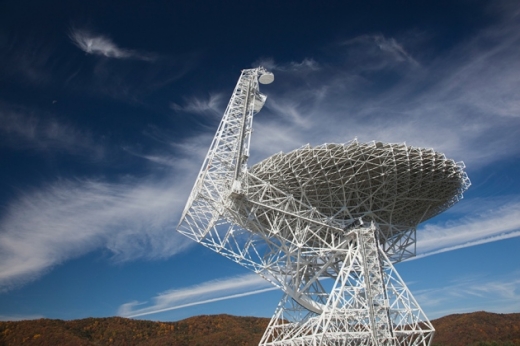
Image: Coming to terms with the search space as SETI proceeds, in this case at Green Bank, WV. Credit: Walter Bibikow/JAI/Corbis /Green Bank Observatory.
The Wright paper shows how our search haystacks can be defined even as we calculate the fraction of them already examined for our hypothetical needles. A quantitative, eight-dimensional model is developed to make the calculation, with a number of differences between the model haystack and the one developed by Tarter, and factoring in recent SETI searches like Breakthrough Listen’s ongoing work. The assumption here, necessary for the calculation, is that SETI surveys have similar search strategies and sensitivities.
This assumption allows the calculation to proceed, and it is given support when we learn that its results align fairly well with the previous calculation Jill Tarter made in a 2010 paper. Thus Wright: “…our current search completeness is extremely low, akin to having searched something like a large hot tub or small swimming pool’s worth of water out of all of Earth’s oceans.”
And then Tarter, whose result for the size of our search is a bit smaller. Let me just quote her (from an NPR interview in 2012) on the point:
“We’ve hardly begun to search… The space that we’re looking through is nine-dimensional. If you build a mathematical model, the amount of searching that we’ve done in 50 years is equivalent to scooping one 8-ounce glass out of the Earth’s ocean, looking and seeing if you caught a fish. No, no fish in that glass? Well, I don’t think you’re going to conclude that there are no fish in the ocean. You just haven’t searched very well yet. That’s where we are.”
This being the case, the idea that a lack of success for SETI to date is a compelling reason to abandon the search is shown for what it is, a misreading of the enormity of the search space. SETI cannot be said to have failed. But this leads to a different challenge. Wright again:
We should be careful, however, not to let this result swing the pendulum of public perceptions of SETI too far the other way by suggesting that the SETI haystack is so large that we can never hope to find a needle. The whole haystack need only be searched if one needs to prove that there are zero needles—because technological life might spread through the Galaxy, or because technological species might arise independently in many places, we might expect there to be a great number of needles to be found.
The paper also points out that in its haystack model are included regions of interstellar space between stars for which there is no assumption of transmitters. Transmissions from nearby stars are but a subset of the haystack, and move up in the calculation of detection likelihood.
So we keep looking, wary of drawing conclusions too swiftly when we have searched such a small part of the available parameter space, and we look toward the kind of searches that can accelerate the process. These would include “…surveys with large bandwidth, wide fields of view, long exposures, repeat visits, and good sensitivity,” according to the paper. The ultimate survey? All sky, all the time, the kind of all-out stare that would flag repeating signals that today could only register as one-off phenomena, and who knows what other data of interest not just to SETI but to the entire community of deep-sky astronomers and astrophysicists.
The paper is Wright et al., “How Much SETI Has Been Done? Finding Needles in the n-Dimensional Cosmic Haystack,” accepted at The Astronomical Journal (preprint).

Trillion Planet Survey Targets M-31
Can rapidly advancing laser technology and optics augment the way we do SETI? At the University of California, Santa Barbara, Phil Lubin believes they can, and he’s behind a project called the Trillion Planet Survey to put the idea into practice for the benefit of students. As an incentive for looking into a career in physics, an entire galaxy may be just the ticket.
For the target is the nearest galaxy to our own. The Trillion Planet Survey will use a suite of meter-class telescopes to search for continuous wave (CW) laser beacons from M31, the Andromeda galaxy. But TPS is more than a student exercise. The work builds on Lubin’s 2016 paper called “The Search for Directed Intelligence,” which makes the case that laser technology foreseen today could be seen across the universe. And that issue deserves further comment.

Centauri Dreams readers are familiar with Lubin’s work with DE-STAR, (Directed Energy Solar Targeting of Asteroids and exploRation), a scalable technology that involves phased arrays of lasers. DE-STAR installations could be used for purposes ranging from asteroid deflection (DE-STAR 2-3) to propelling an interstellar spacecraft to a substantial fraction of the speed of light (DE-STAR 3-4). The work led to NIAC funding (NASA Starlight) in 2015 examining beamed energy systems for propulsion in the context of miniature probes using wafer-scale photonics and is also the basis for Breakthough Starshot.
Image: UC-Santa Barbara physicist Philip Lubin. Credit: Paul Wellman/Santa Barbara Independent.
A bit more background here: Lubin’s Phase I study “A Roadmap to Interstellar Flight ” is available online. It was followed by Phase II work titled “Directed Energy Propulsion for Interstellar Exploration (DEEP-IN).” Lubin’s discussions with Pete Worden on these ideas led to talks with Yuri Milner in late 2015. The Breakthrough Starshot program draws on the DE-STAR work, particularly in its reliance on miniaturized payloads and, of course, a laser array for beamed propulsion, the latter an idea that had largely been associated with large sails rather than chip-sized payloads. Mason Peck and team’s work on ‘sprites’ is also a huge factor.
But let’s get back to the Trillion Planet Survey — if I start talking about the history of beamed propulsion concepts, I could spend days, and anyway, Jim Benford has already undertaken the task in these pages in his A Photon Beam Propulsion Timeline. What’s occupies us this morning is the range of ideas that play around the edges of beamed propulsion, one of them being the beam itself, and how it might be detected at substantial distances. Lubin’s DE-STAR 4, capable of hitting an asteroid with 1.4 megatons of energy per day, would stand out in many a sky.
In fact, according to Lubin’s calculations, such a system — if directed at another star — would be seen in systems as distant as 1000 light years as, briefly, the brightest star in the sky. Suddenly we’re talking SETI, because if we can build such systems in the foreseeable future, so can the kind of advanced civilizations we may one day discover among the stars. Indeed, directed energy systems might announce themselves with remarkable intensity.
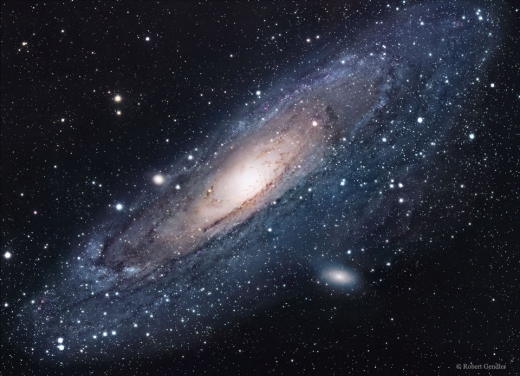
Image: M31, the Andromeda Galaxy, the target of the largely student led Trillion Planet Survey. Credit & Copyright: Robert Gendler.
Lubin makes this point in his 2016 paper, in which he states “… even modest directed energy systems can be ‘seen’ as the brightest objects in the universe within a narrow laser linewidth.” Amplifying on this from the paper, he shows that stellar light in a narrow bandwidth would be very small in comparison to the beamed energy source:
In case 1) we treat the Sun as a prototype for a distant star, one that is unresolved in our telescope (due to seeing or diffraction limits) but one where the stellar light ends up in ~ one pixel of our detector. Clearly the laser is vastly brighter in this sense. Indeed for the narrower linewidth the laser is much brighter than an entire galaxy in this sense. For very narrow linewidth lasers (~ 1 Hz) the laser can be nearly as bright as the sum of all stars in the universe within the linewidth. Even modest directed energy systems can stand out as the brightest objects in the universe within the laser linewidth.
And again (and note here that the reference to ‘class 4’ is not to an extended Kardashev scale, but rather to a civilization transmitting at DE-STAR 4 levels, as defined in the paper):
As can be seen at the distance of the typical Kepler planets (~ 1 kly distant) a class 4 civilization… appears as the equivalent of a mag~0 star (ie the brightest star in the Earth’s nighttime sky), at 10 kly it would appear as about mag ~ 5, while the same civilization at the distance of the nearest large galaxy (Andromeda) would appear as the equivalent of a m~17 star. The former is easily seen with the naked eye (assuming the wavelength is in our detection band) while the latter is easily seen in a modest consumer level telescope.
Out of this emerges the idea that a powerful civilization could be detected with modest ground-based telescopes if it happened to be transmitting in our direction when we were observing. Hence the Trillion Planet Survey, which looks at using small telescopes such as those in the Las Cumbres Observatory’s robotic global network to make such a detection.
With M31 as the target, the students in the Trillion Planet Survey are conducting a survey of the galaxy as TPS gets its software pipeline into gear. Developed by Emory University student Andrew Stewart, the pipeline processes images under a set of assumptions. Says Stewart:
“First and foremost, we are assuming there is a civilization out there of similar or higher class than ours trying to broadcast their presence using an optical beam, perhaps of the ‘directed energy’ arrayed-type currently being developed here on Earth. Second, we assume the transmission wavelength of this beam to be one that we can detect. Lastly, we assume that this beacon has been left on long enough for the light to be detected by us. If these requirements are met and the extraterrestrial intelligence’s beam power and diameter are consistent with an Earth-type civilization class, our system will detect this signal.”
Screening transient signals from its M31 images, the team will then submit them to further processing in the software pipeline to eliminate false positives. The TPS website offers links to background information, including Lubin’s 2016 paper, but as of yet has little about the actual image processing, so I’ll simply quote from a UCSB news release on the matter:
“We’re in the process of surveying (Andromeda) right now and getting what’s called ‘the pipeline’ up and running,” said researcher Alex Polanski, a UC Santa Barbara undergraduate in Lubin’s group. A set of photos taken by the telescopes, each of which takes a 1/30th slice of Andromeda, will be knit together to create a single image, he explained. That one photograph will then be compared to a more pristine image in which there are no known transient signals — interfering signals from, say, satellites or spacecraft — in addition to the optical signals emanating from the stellar systems themselves. The survey photo would be expected to have the same signal values as the pristine “control” photo, leading to a difference of zero. But a difference greater than zero could indicate a transient signal source, Polanski explained. Those transient signals would then be further processed in the software pipeline developed by Stewart to kick out false positives. In the future the team plans to use simultaneous multiple color imaging to help remove false positives as well.
Why Andromeda? The Trillion Planet Survey website notes that the galaxy is home to at least one trillion stars, a stellar density higher than the Milky Way’s, and thus represents “…an unprecedented number of targets relative to other past SETI searches.” The project gets the students who largely run it into the SETI business, juggling the variables as we consider strategies for detecting other civilizations and upgrading existing search techniques, particularly as we take into account the progress of exponentially accelerating photonic technologies.
Projects like these can exert a powerful incentive for students anxious to make a career out of physics. Thus Caitlin Gainey, now a freshman in physics at UC Santa Barbara:
“In the Trillion Planet Survey especially, we experience something very inspiring: We have the opportunity to look out of our earthly bubble at entire galaxies, which could potentially have other beings looking right back at us. The mere possibility of extraterrestrial intelligence is something very new and incredibly intriguing, so I’m excited to really delve into the search this coming year.”
And considering that any signal arriving from M31 would have been enroute for well over 2 million years, the TPS also offers the chance to involve students in the concept of SETI as a form of archaeology. We could discover evidence of a civilization long dead through signals sent well before civilization arose on Earth. A ‘funeral beacon’ announcing the demise of a once-great civilization is a possibility. In terms of artifacts, the search for Dyson Spheres or other megastructures is another. The larger picture is that evidence of extraterrestrial intelligence can come in various forms, including optical or radio signals as well as artifacts detectable through astronomy. It’s a field we continue to examine here, because that search has just begun.
Phil Lubin’s 2016 paper is “The Search for Directed Intelligence,” REACH – Reviews in Human Space Exploration, Vol. 1 (March 2016), pp. 20-45. (Preprint / full text).


